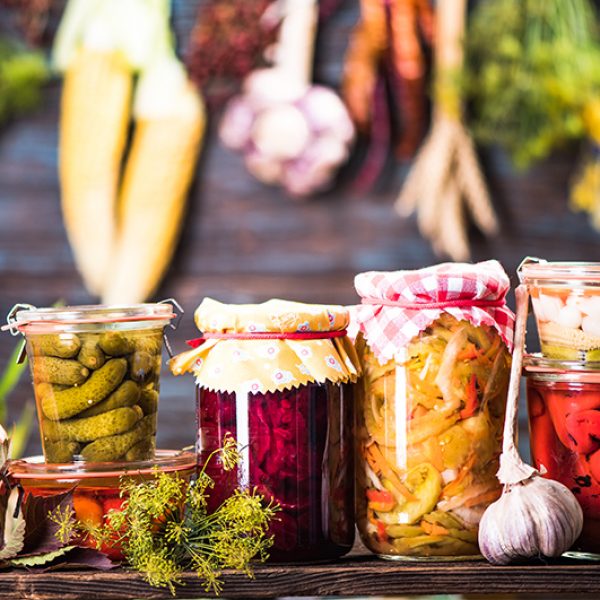

Fermentation: Ancient Wisdom Meets Modern Health Science
What is Food Fermentation?
A food-preparation technique dating back to ancient times, fermentation has been traditionally used to preserve fresh foods and improve their shelf life, increase nutrient density, and enhance flavour. Many well-known fermented foods and beverages (i.e. apple cider vinegar, olives, miso) have also been shown to contain health-promoting phytonutrients, especially polyphenols.1 These potent bioactive compounds have antioxidant properties which protect the body from free radical damage, build immunity, provide energy, and have anti-inflammatory properties.2 A diet high in fermented food has been linked to longevity and prolonged good health in many cultures worldwide, namely the Bulgarian, Hunza, Japanese, and others.3
Food fermentation processes can utilize a wide range of microbes (friendly yeast, molds and bacteria) to achieve the desired physical change to the food or beverage. Depending on the type of end product intended, a wide variety of microbes have been and still are successfully used by many different cultures around the world. Some common examples of these microbes include the mold used to make blue cheese, yeast used to make beer, bacteria for kefir or yogurt, and both bacteria and yeast to make soy sauce.4
Fermentation of SuperFoods – A Great Idea!
In modern-day fermentation processes, fermented superfoods including garlic, maca or turmeric powder (and many more) are produced by a host of similar, if not the same, friendly microbes used in ancient times. Enzymes produced by these beneficial microbes break down or predigest sugars, complex carbohydrate molecules and eliminate digestion-blocking factors found in many superfoods.5 This pre-digestion process significantly improves the body’s ability to assimilate the optimum nutritional value and promote gut health. Antioxidants and many other phytonutrients, naturally-occurring in these superfoods, are converted by friendly bacteria and other microbes into their “free” forms. This enhanced availability allows for more effective and efficient usage within the body2.
Fermented Superfoods Powders: New and Revolutionary
We are now able to both reap the benefits of ancestral fermentation methods and enjoy a variety of safe, convenient and easy-to-take superfood powders. Good-quality fermented superfood ingredients are created using a traditional yet “controlled” whole-food fermentation process. Controlled fermentation encourages the growth of particular microorganisms only to the point at which the desired effect is reached. This controlled process interrupts the fermentation at its optimal point, maximizing the beneficial food transformation and stabilizing the fermented superfood prior to drying.6
As an example, fermentation of cereal grasses (young wheat, barley, alfalfa, and oat plants) transforms and unlocks the nutrients held inside the difficult-to-digest cellulose plant fibre walls. Releasing a nutrient profile similar to dark leafy vegetables, fermented cereal grasses are rich in vitamin K, vitamin B’s, zinc, copper, potassium, manganese, calcium, iron, boron and the enzyme SOD. These young grasses are also high in free amino acids (about 30% by weight), plus chlorophyll. They also contain approximately 40% fibre, both the soluble and insoluble varieties, a key to promoting the healthy production of friendly gut microbes.
To ensure the highest-quality when selecting a fermented superfood powder, choose products which are organic, non-GMO, and gluten-free. Look for superfood cereal grasses (i.e. barley and wheat grasses) grown in Canada.
The results are in!
These days, modern health science is both validating and continuing to evolve many of the world’s food fermentation methods developed over hundreds of generations. We now have access to a great number of convenient bioavailable, nutrient-dense superfood products. It makes sense that the fermented food category now tops the 2019 list of trending superfood choices.7,8
Author: RoseMarie Pierce, B.Sc. Pharm., Holistic Pharmacist
RoseMarie Pierce earned her degree in Pharmacy from Dalhousie University in 1972. After extensive studies in herbology and nutritional medicine, RoseMarie integrated these disciplines with her pharmacy practice to become Canada’s first Holistic Pharmacist. She is recognized as one of Canada’s well-loved integrated health spokespeople and natural health educators. www.Holistic-Pharmacist.com
Author: RoseMarie Pierce, B.Sc. Pharm, on behave of Prairie Naturals Health Products Inc.
References:
- Oboh, G et al. Changes in Polyphenols Distribution and Antioxidant Activity During Fermentation of Some Underutilized Legume. Food Science and Technology International. 2009;15: 41-46.
- Cardona, F et al. Benefits of polyphenols on gut microbiota and implications in human health. The J. of Nut Biochem. Volume 24, Issue *, Aug 2013, Pages 1415-1422 https://www.sciencedirect.com/journal/the-journal-of-nutritional-biochemistry/vol/24/issue/8
- Chilton, S et al. Inclusion of Fermented Foods in Food Guides around the World. Nutrients. 2015 Jan; 7(1): 390–404. https://www.ncbi.nlm.nih.gov/pmc/articles/PMC4303846/
- Rezac, S et al. Fermented Foods as a Dietary Source of Live Organisms. Front in Microbiol, 2018; 9:1785. https://www.ncbi.nlm.nih.gov/pmc/articles/PMC6117398/
- Reddy, N.R., Pierson, M.D. Reduction in antinutritional and toxic components in plant foods by fermentation. Food Res Int’l, Volume 27, Issue 3, 1994, pg. 281-290 https://wwsciencedirect.com/science/article/pii/0963996994900965
- Borresen, Erica et al. Fermented Foods: Patented Approaches and Formulations for Nutritional Supplementation and Health Promotion. Pat Food Nutr Agric. 2012 Aug; 4(2): 134-140 https://www.ncbi.nlm.nih.gov/pmc/articles/PMC5175401/